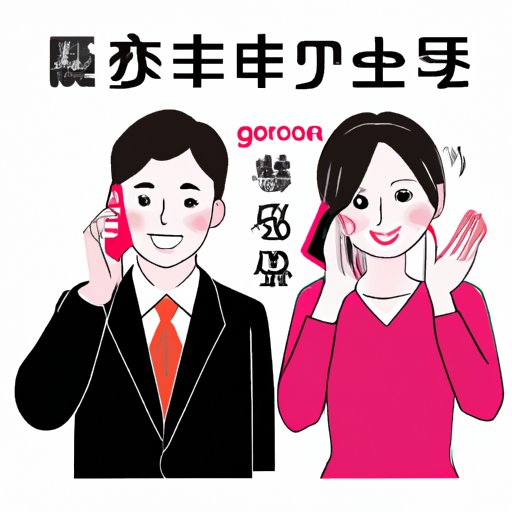I. Introduction
Knowing how to say hello in Japanese can be a useful and important skill, whether you want to travel to Japan, communicate with Japanese colleagues or friends, or simply learn another language. In Japan, greetings are an essential part of social interactions and can convey respect, politeness, or informality, depending on the situation. This article will provide a comprehensive guide to different types of Japanese greetings, including basic, respect, casual, formal, phone calls, informal situations among friends, and business situations.
II. Basic Japanese greeting: “Konnichiwa”
The most widely known and commonly used Japanese greeting is “Konnichiwa,” which translates to “hello” or “good afternoon.” This greeting is appropriate to use in most situations during the daytime, especially when meeting someone for the first time, entering a store, or beginning a conversation with an acquaintance.
For example, you might say “Konnichiwa” to greet a shopkeeper, a coworker, or a new friend. It can also be used as a polite way to answer the phone.
When using “Konnichiwa,” it’s important to bow slightly as a sign of respect, keeping in mind that the depth of the bow depends on the formality of the situation.
III. Respectful greeting: “Ohayou gozaimasu”
The phrase “Ohayou gozaimasu” means “good morning” and is a more formal and respectful greeting than “Konnichiwa.” It is appropriate to use in early morning meetings, especially with superiors, elders, or strangers. In Japanese culture, using the correct level of formality in greetings is a sign of respect and politeness.
For example, you might say “Ohayou gozaimasu” to greet your Japanese host family, a business partner, or a client during a morning meeting.
When using “Ohayou gozaimasu,” be sure to bow politely to show your respect.
IV. Casual greeting: “Genki” or “Genki desu ka”
“Genki” is a casual Japanese greeting that means “how are you?” or “Are you well?” It’s a good way to greet friends, classmates, or peers around the same age. You can use “Genki” in any situation where you want to express your friendly, casual tone.
You might say “Genki desu ka?” to your Japanese friends when you see them at school, work, or social events. It’s also appropriate to use this greeting when you talk to someone you haven’t seen in a while and want to know how they’re doing.
When using “Genki” or “Genki desu ka,” it’s important to smile and keep a relaxed posture, as this is a casual, friendly greeting.
V. Formal greeting: “Kombanwa”
“Kombanwa” means “good evening” and is a more formal greeting than “Konnnichiwa,” making it suitable for evening meetings or formal events. The Japanese language has some subtle differences in tone and usage between daytime and evening greetings, and using the appropriate greeting can convey a sense of cultural awareness and respect.
You might use “Kombanwa” to greet your dinner guests, coworkers during an evening meeting, or a formal gathering.
When using “Kombanwa,” it’s important to bow slightly, maintaining an appropriate level of formality for the situation.
VI. Greeting for phone calls: “Moshi moshi”
“Moshi moshi” is commonly used as a greeting when answering phone calls in Japan. It is considered a polite way to answer the phone, especially when you’re talking to someone you don’t know, or someone you haven’t spoken to in a while. It’s believed that “Moshi Moshi” has its roots in traditional Japanese theater, where actors would use it to get the crowd’s attention.
When using “Moshi moshi” during phone calls, it’s important to clearly emphasize the word in a high-pitched and friendly tone, so that the other person can easily recognize you.
VII. Greeting for informal situations among friends: “Yo” or “Yahho”
“Yo” or “Yahho” is a casual and informal Japanese greeting commonly used among friends. It is a more laid-back greeting and is appropriate to use in situations where you are familiar with each other and want to convey a sense of closeness and geniality.
For example, you might use “Yo” or “Yahho” to greet your close friends when you hang out, go for a walk, or talk on the phone.
When using “Yo” or “Yahho,” it’s important to use a friendly and relaxed tone of voice and be mindful of the social context of the situation.
VIII. Greeting for business situations: “O-sakini shitsurei shimasu”
“O-sakini shitsurei shimasu” translates to “excuse me for leaving before you” and is a formal greeting used in business situations to show respect to higher-ranking colleagues or clients. It is used when ending a meeting or leaving a gathering, and is a way to thank the host or the most senior person present for the opportunity to present their ideas or contribution to the discussion.
When using “O-sakini shitsurei shimasu,” it’s important to bow deeply as a sign of respect and to thank them for their time.
IX. Conclusion
Knowing how to say hello in Japanese is an essential skill when communicating with Japanese people or understanding Japanese culture. Understanding the different types of Japanese greetings and the social nuances behind them can help you navigate social situations with confidence and respect. Be sure to take into account the context of the situation, the level of formality needed, and cultural values when greeting someone in Japan.
By learning about Japanese language and culture, you can not only improve your language skills but also gain a greater appreciation of the rich and diverse world of Japan.
